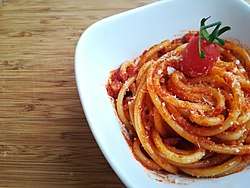Amatriciana sauce
Sugo all'amatriciana (Italian pronunciation: [ˈsuːɡo allamatriˈtʃaːna]), or alla matriciana (in Romanesco dialect),[1] also known as salsa all'amatriciana, is a traditional Italian pasta sauce based on guanciale (cured pork cheek), pecorino cheese from Amatrice, tomato, and, in some variations, onion. Originating from the town of Amatrice (in the mountainous Province of Rieti of Lazio region), the Amatriciana is one of the best known pasta sauces in present-day Roman and Italian cuisine. The Italian government has named it a traditional agro-alimentary product of Lazio.
 Bucatini all'amatriciana | |
| Course | Primo |
|---|---|
| Place of origin | Italy |
| Region or state | Lazio |
| Serving temperature | Hot over pasta |
| Main ingredients | Tomatoes, guanciale, cheese (Pecorino Romano), olive oil |
Development
Amatriciana originates from a recipe named gricia. Grici were what Romans—modern dwellers of Rome, not the ancient ones—called the sellers of bread and comestibles.[2] They were so called in that a number of them emigrated from the Swiss canton of Grisons.[2] According to another hypothesis, the name originates from the hamlet of Grisciano, in the comune of Accumoli, near Amatrice. The sauce - nowadays named also Amatriciana bianca [3]- was (and still is) prepared with guanciale (cured pork cheek) and grated pecorino. At some point, a little olive oil was added to the recipe. In the 1960s, the Amatriciana sauce was still prepared in this way in Amatrice itself.[4]
The invention of the first tomato sauces (and the likely earliest date for the introduction of tomato in the gricia, creating the Amatriciana) dates back to the late 18th century. The first written record of pasta with tomato sauce can be found in the 1790 cookbook L'Apicio Moderno by Roman chef Francesco Leonardi.[5]
The Amatriciana recipe became increasingly famous in Rome over the 19th and early 20th centuries, due to the centuries-old connection[6] between Rome and Amatrice.[7] The recipe was extremely well received and rapidly went on to be considered a classic of Roman cuisine, even though it originated elsewhere. The name of the dish in the Romanesco dialect eventually became matriciana due to the apheresis typical of this dialect.[8]
While tomato-less gricia is still prepared in central Italy, it is the tomato-enriched amatriciana that is better known throughout Italy and exported everywhere. While in Amatrice the dish is prepared with spaghetti, the use of bucatini has become extremely common in Rome and is now prevalent. Other types of dry pasta (particularly rigatoni) are also used, whereas fresh pasta is generally avoided.
Variants
The recipe is known in several variants depending, among other things, on the local availability of certain ingredients. In Amatrice, the use of guanciale and tomato, onion is not favored, but is shown in the classical handbooks of Roman cuisine.[9][10] For frying, olive oil is most commonly used, but strutto (canned pork lard) is used as well.[9]
The addition of garlic sauteed in olive oil, before adding the guanciale is also accepted , and for cheese either pecorino romano[9][10] or Amatrice's pecorino (from the Monti Sibillini or Monti della Laga areas) can be used. The addition of black or chili pepper is common.
Notes
- Ravaro (2005), p. 395
- Ravaro (2005), p. 329
- Gentilcore, David (2010). Pomodoro! A History of the Tomato in Italy. New York: Columbia University Press. p. 184. ISBN 023115206X.
- Gosetti (1967), p. 686
- Faccioli (1987), The culí di pomodoro recipe is found in the chapter devoted to Leonardi, at pg.756
- In Rione Ponte A lane called Vicolo dei Matriciani and a locanda bearing the same name are documented as having existed since the 17th century. Blasi (1923), sub voce
- The town was originally part of the Abruzzo Ultra Department of the Kingdom of the Two Sicilies, but was annexed to the Abruzzi Region of the Kingdom of Italy in 1861, and was finally incorporated into Lazio as part of the Province of Rieti when the latter was created in 1927.
- Ravaro (2005), p. 395
- Boni (1983), pg. 44.
- Carnacina (1975), pg. 82.
Sources
- Blasi, Benedetto (1923). Vie piazze e ville di Roma nel loro valore storico e topografico (in Italian). Roma: Libreria di scienze e lettere.
- Boni, Ada (1983) [1930]. La Cucina Romana (in Italian). Roma: Newton Compton Editori.
- Gosetti Della Salda, Anna (1967). Le ricette regionali italiane (in Italian). Milano: Solares.
- Carnacina, Luigi; Buonassisi, Vincenzo (1975). Roma in Cucina (in Italian). Milano: Giunti Martello.
- Faccioli, Emilio (1987). L'Arte della cucina in Italia (in Italian). Milano: Einaudi.
- Ravaro, Fernando (2005). Dizionario romanesco (in Italian). Roma: Newton Compton. ISBN 9788854117921.
